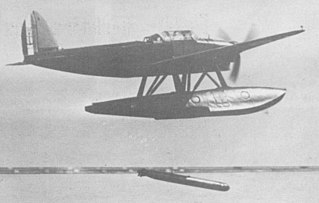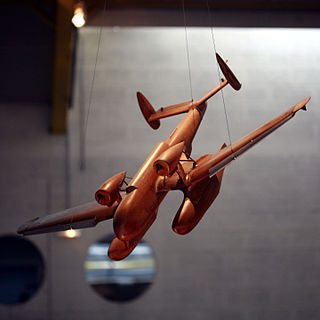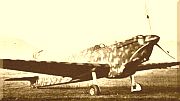See also
Aircraft of comparable role, configuration, and era
| D.750 | |
|---|---|
| Role | Torpedo bomber |
| National origin | France |
| Manufacturer | SNCAM |
| First flight | 6 May 1940 |
| Status | Prototype |
| Number built | 1 |
The Dewoitine D.750 was a prototype French twin-engined torpedo bomber. It was designed prior to the outbreak of the Second World War to operate from the aircraft carriers of the French Navy, but only a single example was completed, with development ended by France's defeat by Germany in June 1940.
In 1937, the French Air Ministry drew up a specification for a twin-engined torpedo bomber to operate from the French Navy's two planned new aircraft carriers, the Joffre and Painlevé. The Société nationale des constructions aéronautiques du Midi (SNCAM) submitted a design (which was developed by the design team formerly of Dewoitine), that became part of SNCAM when it was established in 1937. [1]
SNCAM's design, the Dewoitine D.750 was a low-winged monoplane of all-metal stressed skin construction, powered by two Renault 12R air-cooled V12 engines. It was fitted with a retractable tailwheel undercarriage and a twin tail. The fuselage, of similar layout to the competing SNCAO CAO.600 housed the crew of two or three required by the specification in separate cockpits. The bombardier/navigator sat in the nose, with the pilot sitting behind him, above and to the left of the navigator. The radio operator/gunner sat aft of the wing, operating Darne machine guns in dorsal and ventral positions. [2]
Two prototypes of the D.750 were ordered by the French Air Ministry on 26 June 1939, [1] the first example making its maiden flight on 6 May 1940 with SNCAM's chief test pilot Marcel Doret at the controls. [3] A few days later, however, Nazi Germany invaded France and the Low countries, and the first prototype had not completed manufacturers tests before France surrendered on 25 June. This caused development of the D.750 to be abandoned, with the second prototype incomplete. [4]
Data from War Planes of the Second World War: Volume Eight Bombers and Reconnaissance Aircraft [4]
General characteristics
Performance
Armament
Aircraft of comparable role, configuration, and era

The Bloch MB.130 and its derivatives were a series of French monoplane reconnaissance-bombers developed during the 1930s. They saw some limited action at the beginning of World War II but were obsolete by that time and suffered badly against the Luftwaffe. After the fall of France, a few were pressed into Luftwaffe service.

The MB.210 and MB.211 were the successors of the French Bloch MB.200 bomber built by Societé des Avions Marcel Bloch in the 1930s and differed primarily in being low wing monoplanes rather than high wing monoplanes.

The Bloch MB.170 and its derivatives were French reconnaissance bombers designed and built shortly before the Second World War. They were the best aircraft of this type available to the Armée de l'Air at the outbreak of the war, with speed, altitude and manoeuvrability that allowed them to evade interception by the German fighters. Although the aircraft could have been in service by 1937, debate over what role to give the aircraft delayed deliveries until 1940.

The Heinkel He 59 was a twin-engined German biplane designed in 1930, resulting from a requirement for a torpedo bomber and reconnaissance aircraft able to operate on wheeled landing gear or twin-floats.

The Latécoère 298 was a French seaplane that served during World War II. It was designed primarily as a torpedo bomber, but served also as a dive bomber against land and naval targets, and as a maritime reconnaissance aircraft. Of a sturdy and reliable construction and possessing good manoeuvrability, it was France's most successful military seaplane, and served throughout the war in various guises.

The CAC Woomera, also known as the CAC CA-4 and CAC CA-11, was an Australian bomber aircraft that was designed and constructed by the Commonwealth Aircraft Corporation during World War II. The order for the Woomera was cancelled before it became operational with the Royal Australian Air Force (RAAF).
The Latécoère 611 was a French four-engined maritime reconnaissance flying boat of the Second World War. Although only a single prototype was completed, this served throughout the war, being used by both the Vichy French and Free French navies.

The Caproni Ca.313 was an Italian twin-engine reconnaissance bomber of the late-1930s. It was a development of the Ca.310. Its variants were exported to several other countries.

The Farman NC.470 was a French twin-engined floatplane designed as a crew trainer for the French Navy. It was used in small numbers for both its intended role as a trainer and as a coastal reconnaissance aircraft at the start of World War II.

The Blohm & Voss Ha 140 was a German multi-purpose seaplane first flown in 1937. It was intended for use as a torpedo bomber or long-range reconnaissance aircraft, but did not enter production.

The Loire-Nieuport 10 was a 1930s French prototype long-range maritime reconnaissance and combat floatplane produced by Loire-Nieuport, a joint venture between Loire Aviation and Nieuport-Delage. It was an attempt to answer the requirements for the Navy's programme Hydravion éclaireur de combat for a large floatplane capable of acting as a torpedo bomber or reconnaissance aircraft.

The Caproni Ca.335 Maestrale (Mistral) was an Italian single-engined two-seat fighter-bomber/reconnaissance aircraft of the 1930s.
The Dewoitine HD.730 was a prototype French reconnaissance floatplane of the 1940s. It was a single-engined, low-wing monoplane that was designed as a catapult-launched reconnaissance aircraft to operate from warships of the French Navy. Two flew in 1940, and a third aircraft was built to a modified design in 1941, but no production followed.
The Bloch MB.480 was a French twin-engined torpedo-bomber/reconnaissance floatplane designed just before the start of the Second World War by Société des Avions Marcel Bloch. Only two were built, the French Navy deciding to use landplanes instead.

The SNCAO CAO.600 was a French prototype twin-engined torpedo-bomber of the Second World War. It was intended to operate from two new aircraft carriers of the French Navy, but only a single example had been completed and flown when the surrender of France in June 1940 ended development of the aircraft.

The SNCAC NC.150 was a prototype French high-altitude bomber aircraft designed and flown just prior to the start of the Second World War. It was a twin-engined monoplane, with a third engine driving a supercharger. Although testing was promising, and orders were planned for a modified version as a back-up for the Lioré et Olivier LeO 45 and Amiot 354 bombers, the surrender of France in June 1940 ended development with only the single example being built.

The SNCAO 200, sometimes written CAO.200, was a prototype French single seat fighter aircraft of the 1930s. It was a single engined monoplane intended to compete with the Dewoitine D.520, but was unsuccessful, only a single example being built.
The Dewoitine D.770 was a prototype French twin-engined attack aircraft of the late 1930s. It was intended as a replacement for the Breguet 693 but testing was incomplete by the time that France surrendered to Germany, and no production followed.
The Potez 220 was a prototype French twin-engined, three-seat reconnaissance and army cooperation aircraft. Two examples were built in 1939, but no production followed.
The Dewoitine D.720 T3 was a French reconnaissance/cooperation aircraft built by Dewoitine in the late 1930s.